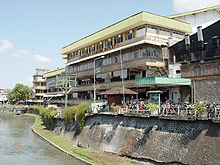Denpasar
![]()
This article or section needs revision. More details should be given on the discussion page. Please help improve it, and then remove this tag.
Denpasar (translated roughly 'Central Market', during Dutch colonial rule also Den Pasar) is a city in the south of the Indonesian island of Bali. The largest city on the island is also the capital of the province of Bali.
The population explosion of the city is remarkable. In 2000, the city had 387,477 inhabitants, which had increased to 637,701 in 2010 due to immigration from both Bali and other islands and self-propagation.
In the center of the city is Puputan Square. It commemorates by name and with a monument the ritual mass suicide (Puputan) in 1906. The reigning king I Gusti Ngurah Made Agung, together with his court, resisted the Dutch military force that had landed in Sanur and was marching towards the town, although the king was well aware of the futility of attacking a modern army with a few shotguns and the kris. The Dutch gunfire and artillery killed almost the entire court and army, fulfilling the prophecy the king himself had found in his Lontar studies.
Until that time, the center of the kingdom of Badung was located here. The colonization of the region ended the regency and the city was given a new name. As a trading center, it was henceforth called Denpasar. The imperial temple of Pura Jagatnatha, dating from 1432 and destroyed during the 1906 Puputan, was partially rebuilt in 1908. In 2011, an extensive reconstruction according to old models was completed.
Denpasar has been separated from the rest of Badung as a city district since 27 February 1992. The county (Kabupaten) Badung borders north / southwest. To the east lies the county of Gianyar. Denpasar includes the traditional seaside resort of Sanur, which is held in high esteem by the Balinese for ritual cleansings and final ceremonies of cremations of the dead (Ngaben). There you will find the temple of Baruna, the god of the sea, on the beach.
In addition, the turtle island Serangan with its turtle station and the important temple Pura Sakenan belongs to Denpasar. Eating turtle meat was part of practically all important ceremonies in Bali before the animals were protected.

Kembasari market at Badung, Denpasar Barat
Population development
The population in the Denpasar agglomeration grew from 34,000 in 1950 to 924,000 in 2017. By 2035, 1.3 million inhabitants are expected.
| Population development of the agglomeration according to UN | |
| Year | Population |
| 1950 | 34.000 |
| 1960 | 54.000 |
| 1970 | 83.000 |
| 1980 | 131.000 |
| 1990 | 206.000 |
| 2000 | 533.000 |
| 2010 | 792.000 |
| 2017 | 924.000 |
Traffic
The street system is hierarchically strongly structured. There are some main roads, e.g. Jalan Gatot Subroto in the north and east or Jalan Gajah Mada (the name changes several times in the course) in the center. Furthermore, Denpasar is developed with roads like a checkerboard, only the rivers, especially the Badung, force some deviations from this pattern. The river valleys are mostly deeply cut due to the erosion-prone rock, and bridge heights of over 10 m are the rule rather than the exception.
However, only approx. 40% of the residential development is accessible via this road system. The remaining approx. 60 % are served by single-lane (partly only 2 m wide) alleys (id. gangway) leading from them. Unlike many main streets, they can be used in both directions of travel. These alleys open up the squares in a herringbone fashion. They are usually not connected to each other along their entire length.
The main roads are often four or more lane one-way streets with raised median strips from the time of two-way traffic, which always causes traffic jams at the few interchanges.
Typical for the city (as for the whole of Bali) is the building up to the property line. Either, especially in the center or the Islamic quarters such as Kampung jawa, the building itself or the property wall (in better quarters with larger properties but also around public buildings) limit the public street space quite physically, so that the traffic space is clearly limited. Sidewalks (usually on both sides) are present along streets and magistrals and are protected from traffic by curbs about 30 cm high, alternating between black and white.
Denpasar is the transport hub of Bali. The city is choked with traffic and public transport exists only in the form of bemos, taxis and intercity buses, which serve three main terminals in Denpasar.
Regulated public transport or rail-based transport systems do not exist and have never existed. Bali's first public bus line in the sense of a public transport system, the Trans Sarbagita (all-day 15-minute service) Corridor 2, has been operating since 18 August 2011 and only touches Denpasar in the southeast. A second line has been operating from the city centre to the airport since summer 2012. Access lines with minibuses are also operated. The number of users has doubled as a result, but there can be no talk of a network effect or even relief for the roads. There is no basis for this, such as through-tariffing or guaranteed connections. Instead, the conductors on the bus only sell single tickets.
Denpasar Airport is located about 12 kilometers and about 30 minutes south of downtown on the isthmus to Nusa Dua at Tuban in Badung.
Search within the encyclopedia